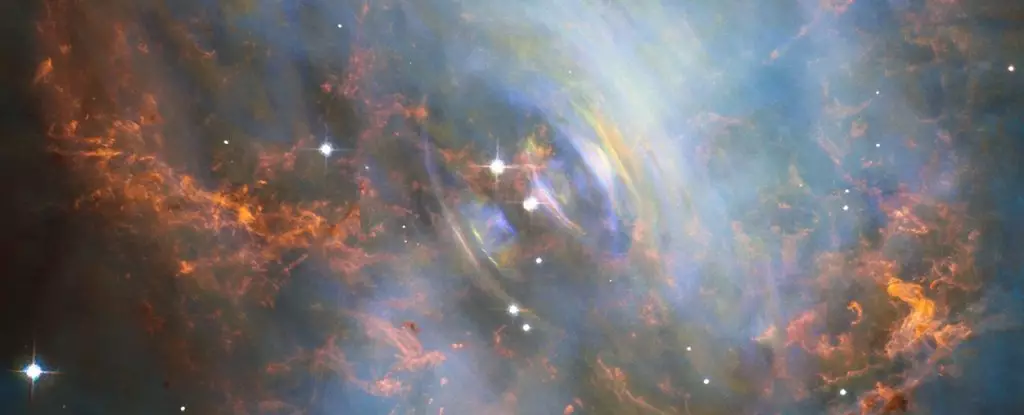Deep in the cosmos, approximately 6,200 light-years away, resides the Crab Pulsar, a celestial phenomenon that has fascinated astronomers for decades. This remnant of a massive star’s supernova explosion, which occurred in 1054 CE, is not just an ordinary neutron star; it emits pulses of radio light that provide insight into the laws of physics at extreme scales. The pulsar represents the remnants of stellar death, where the core collapses to form an incomprehensibly dense neutron star, generating remarkable electromagnetic signals. However, the Crab Pulsar has remained shrouded in mystery, as scientists have struggled for years to understand the origins of a particularly puzzling radio signal known as the “zebra pattern.”
Discovered in 2007, the zebra pattern is a striking phenomenon characterized by its unique band structure. When graphed, these radio waves exhibit an unusual spiky design reminiscent of a zebra’s stripes, setting them apart from other celestial signals. Despite extensive observational data collected since the pulsar’s discovery in the 1960s, the reason for the zebra pattern eluded explanation until recent insights emerged. This signal, unique to the Crab Pulsar, seems to defy the typical emission characteristics observed in other neutron stars, thereby positioning itself as a conundrum within the astrophysical community.
Recent developments from Mikhail Medvedev, a theoretical astrophysicist at the University of Kansas, propose a compelling solution to this longstanding mystery. Medvedev hypothesizes that the zebra pattern results from an interference effect caused by varying plasma densities within the pulsar’s magnetosphere. By applying the principles of wave optics, he presents a model that describes how electromagnetic waves interact with both the pulsar’s strong magnetic field and its intricate plasma arrangement, leading to this unique emission pattern.
In his explanation, Medvedev draws an analogy to wave behavior in everyday scenarios. For instance, when electromagnetic waves encounter obstacles, they do not travel in a straight line as one would expect. Instead, they bend and create regions of higher and lower intensity due to constructive and destructive interference. This concept of diffraction is critical to understanding why the Crab Pulsar’s emissions appear in such an extraordinary way.
To fully appreciate the significance of the zebra pattern, it is essential to understand the nature of neutron stars and pulsars. A neutron star is formed from the remnants of a supernova explosion. When the core of a massive star collapses, protons and electrons combine to form neutrons, resulting in an incredibly dense mass—one that could contain over twice the mass of the Sun compressed into a sphere just 20 kilometers wide. Pulsars, a subtype of neutron stars, emit beams of radiation that sweep across space as they spin. The Crab Pulsar, rotating approximately 30 times per second, captures our attention with its rapid pulses, similar to the flickering of a lighthouse.
The implications of Medvedev’s findings extend beyond the Crab Pulsar. His model could serve as a pioneering tool for measuring plasma densities within the magnetospheres of other celestial bodies. Although the Crab Pulsar is somewhat unique due to its youth and energetic emissions, the methodology could potentially apply to other known pulsars, enriching our understanding of the universe. Indeed, numerous pulsars exhibit similar phenomena, allowing for a broader exploration of the physics governing these enigmatic objects.
Furthermore, the implications of studying such high-energy cosmic phenomena reach into fundamental physics. The observations made in the Crab Pulsar’s magnetic field may provide valuable insights into the intricacies of electromagnetic theory, quantum mechanics, and the underlying nature of cosmic structures. By unearthing the underlying mechanisms of the zebra pattern, researchers might unlock secrets that transcend merely pulsar studies, reaching into the fabric of celestial mechanics and theories of relativity.
The ongoing research surrounding the Crab Pulsar and its zebra pattern not only illustrates the complexities of neutron stars but also highlights the sophistication of theoretical astrophysics. As astronomers and physicists continue their quest to unravel these cosmic mysteries, the Crab Pulsar stands as a testament to the enduring human fascination with the universe. With every discovery, we inch closer to understanding the profound phenomena at play in the cosmos, forever pushing the boundaries of our knowledge.

